Fermi Problem: A Case of International Rescue
VerifiedAdded on 2023/01/23
|11
|2309
|56
AI Summary
This article discusses the concept of Fermi Problem in the context of international rescue operations. It explores the role of International Rescue in providing humanitarian aid and the challenges faced in relief operations. The article emphasizes the importance of proper planning and allocation of resources in disaster management.
Contribute Materials
Your contribution can guide someone’s learning journey. Share your
documents today.

FERMI PROBLEM; A CASE OF INTERNATIONAL RESCUE
1
FERMI PROBLEM; A CASE OF INTERNATIONAL RESCUE
1
FERMI PROBLEM; A CASE OF INTERNATIONAL RESCUE
Secure Best Marks with AI Grader
Need help grading? Try our AI Grader for instant feedback on your assignments.
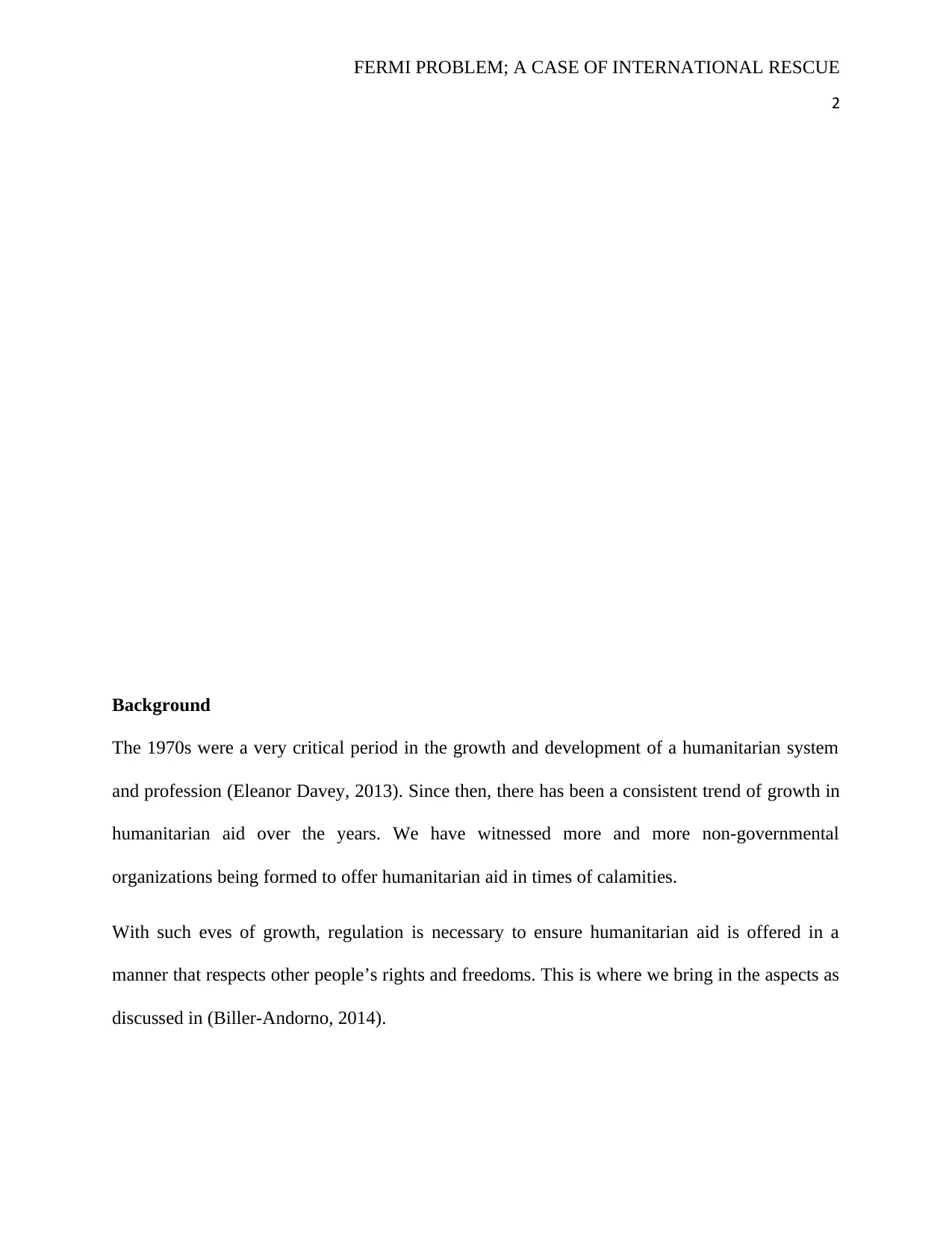
FERMI PROBLEM; A CASE OF INTERNATIONAL RESCUE
2
Background
The 1970s were a very critical period in the growth and development of a humanitarian system
and profession (Eleanor Davey, 2013). Since then, there has been a consistent trend of growth in
humanitarian aid over the years. We have witnessed more and more non-governmental
organizations being formed to offer humanitarian aid in times of calamities.
With such eves of growth, regulation is necessary to ensure humanitarian aid is offered in a
manner that respects other people’s rights and freedoms. This is where we bring in the aspects as
discussed in (Biller-Andorno, 2014).
2
Background
The 1970s were a very critical period in the growth and development of a humanitarian system
and profession (Eleanor Davey, 2013). Since then, there has been a consistent trend of growth in
humanitarian aid over the years. We have witnessed more and more non-governmental
organizations being formed to offer humanitarian aid in times of calamities.
With such eves of growth, regulation is necessary to ensure humanitarian aid is offered in a
manner that respects other people’s rights and freedoms. This is where we bring in the aspects as
discussed in (Biller-Andorno, 2014).
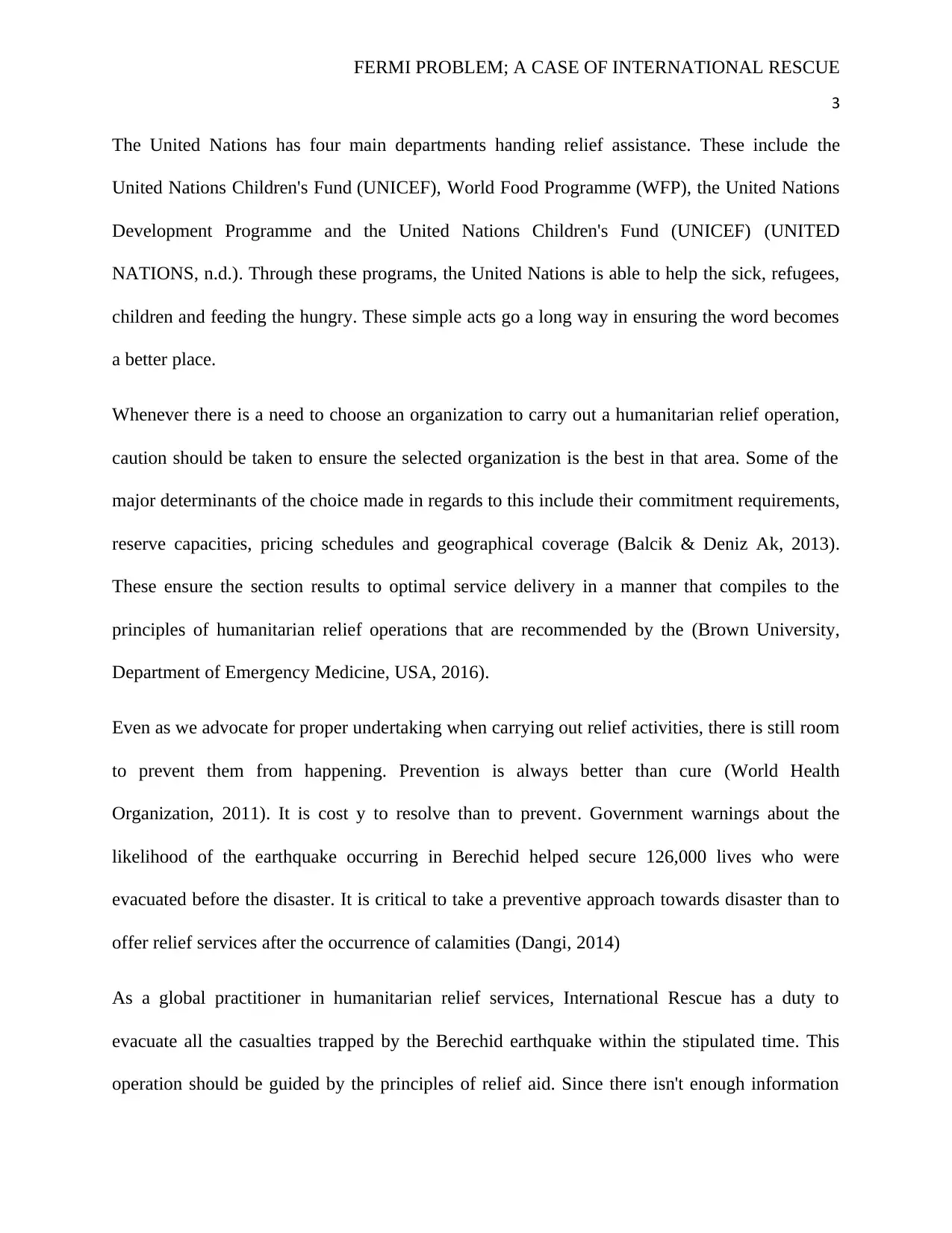
FERMI PROBLEM; A CASE OF INTERNATIONAL RESCUE
3
The United Nations has four main departments handing relief assistance. These include the
United Nations Children's Fund (UNICEF), World Food Programme (WFP), the United Nations
Development Programme and the United Nations Children's Fund (UNICEF) (UNITED
NATIONS, n.d.). Through these programs, the United Nations is able to help the sick, refugees,
children and feeding the hungry. These simple acts go a long way in ensuring the word becomes
a better place.
Whenever there is a need to choose an organization to carry out a humanitarian relief operation,
caution should be taken to ensure the selected organization is the best in that area. Some of the
major determinants of the choice made in regards to this include their commitment requirements,
reserve capacities, pricing schedules and geographical coverage (Balcik & Deniz Ak, 2013).
These ensure the section results to optimal service delivery in a manner that compiles to the
principles of humanitarian relief operations that are recommended by the (Brown University,
Department of Emergency Medicine, USA, 2016).
Even as we advocate for proper undertaking when carrying out relief activities, there is still room
to prevent them from happening. Prevention is always better than cure (World Health
Organization, 2011). It is cost y to resolve than to prevent. Government warnings about the
likelihood of the earthquake occurring in Berechid helped secure 126,000 lives who were
evacuated before the disaster. It is critical to take a preventive approach towards disaster than to
offer relief services after the occurrence of calamities (Dangi, 2014)
As a global practitioner in humanitarian relief services, International Rescue has a duty to
evacuate all the casualties trapped by the Berechid earthquake within the stipulated time. This
operation should be guided by the principles of relief aid. Since there isn't enough information
3
The United Nations has four main departments handing relief assistance. These include the
United Nations Children's Fund (UNICEF), World Food Programme (WFP), the United Nations
Development Programme and the United Nations Children's Fund (UNICEF) (UNITED
NATIONS, n.d.). Through these programs, the United Nations is able to help the sick, refugees,
children and feeding the hungry. These simple acts go a long way in ensuring the word becomes
a better place.
Whenever there is a need to choose an organization to carry out a humanitarian relief operation,
caution should be taken to ensure the selected organization is the best in that area. Some of the
major determinants of the choice made in regards to this include their commitment requirements,
reserve capacities, pricing schedules and geographical coverage (Balcik & Deniz Ak, 2013).
These ensure the section results to optimal service delivery in a manner that compiles to the
principles of humanitarian relief operations that are recommended by the (Brown University,
Department of Emergency Medicine, USA, 2016).
Even as we advocate for proper undertaking when carrying out relief activities, there is still room
to prevent them from happening. Prevention is always better than cure (World Health
Organization, 2011). It is cost y to resolve than to prevent. Government warnings about the
likelihood of the earthquake occurring in Berechid helped secure 126,000 lives who were
evacuated before the disaster. It is critical to take a preventive approach towards disaster than to
offer relief services after the occurrence of calamities (Dangi, 2014)
As a global practitioner in humanitarian relief services, International Rescue has a duty to
evacuate all the casualties trapped by the Berechid earthquake within the stipulated time. This
operation should be guided by the principles of relief aid. Since there isn't enough information
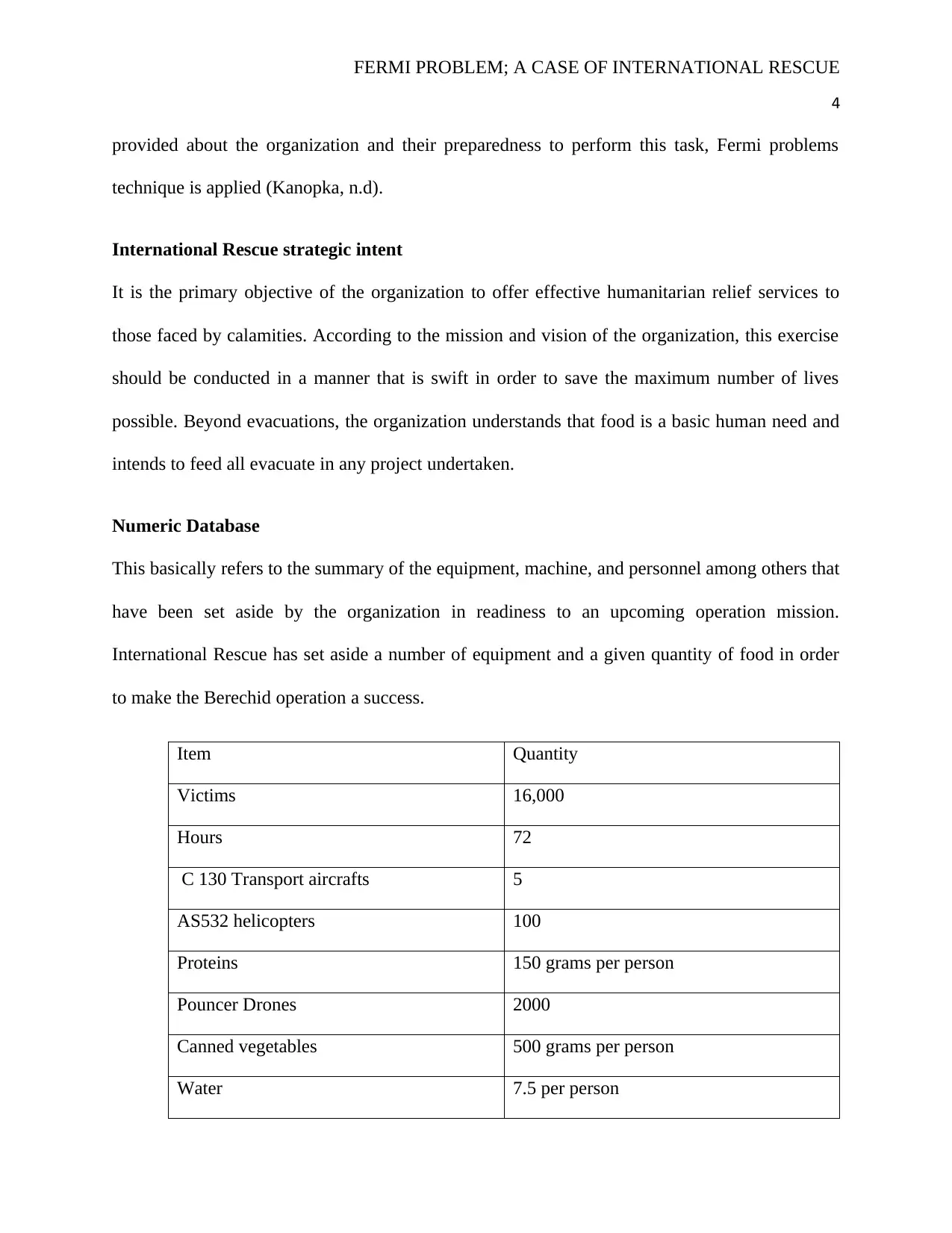
FERMI PROBLEM; A CASE OF INTERNATIONAL RESCUE
4
provided about the organization and their preparedness to perform this task, Fermi problems
technique is applied (Kanopka, n.d).
International Rescue strategic intent
It is the primary objective of the organization to offer effective humanitarian relief services to
those faced by calamities. According to the mission and vision of the organization, this exercise
should be conducted in a manner that is swift in order to save the maximum number of lives
possible. Beyond evacuations, the organization understands that food is a basic human need and
intends to feed all evacuate in any project undertaken.
Numeric Database
This basically refers to the summary of the equipment, machine, and personnel among others that
have been set aside by the organization in readiness to an upcoming operation mission.
International Rescue has set aside a number of equipment and a given quantity of food in order
to make the Berechid operation a success.
Item Quantity
Victims 16,000
Hours 72
C 130 Transport aircrafts 5
AS532 helicopters 100
Proteins 150 grams per person
Pouncer Drones 2000
Canned vegetables 500 grams per person
Water 7.5 per person
4
provided about the organization and their preparedness to perform this task, Fermi problems
technique is applied (Kanopka, n.d).
International Rescue strategic intent
It is the primary objective of the organization to offer effective humanitarian relief services to
those faced by calamities. According to the mission and vision of the organization, this exercise
should be conducted in a manner that is swift in order to save the maximum number of lives
possible. Beyond evacuations, the organization understands that food is a basic human need and
intends to feed all evacuate in any project undertaken.
Numeric Database
This basically refers to the summary of the equipment, machine, and personnel among others that
have been set aside by the organization in readiness to an upcoming operation mission.
International Rescue has set aside a number of equipment and a given quantity of food in order
to make the Berechid operation a success.
Item Quantity
Victims 16,000
Hours 72
C 130 Transport aircrafts 5
AS532 helicopters 100
Proteins 150 grams per person
Pouncer Drones 2000
Canned vegetables 500 grams per person
Water 7.5 per person
Secure Best Marks with AI Grader
Need help grading? Try our AI Grader for instant feedback on your assignments.
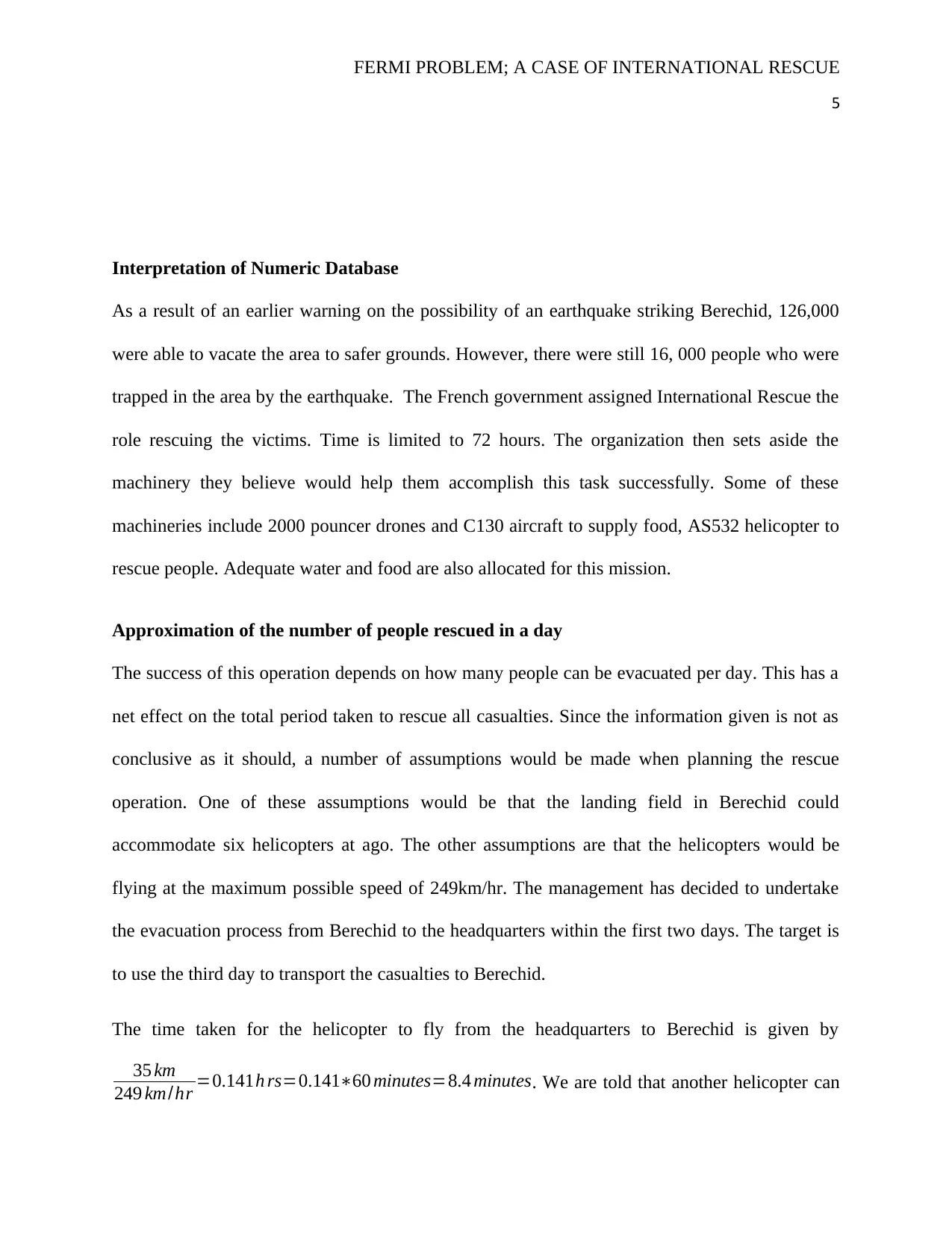
FERMI PROBLEM; A CASE OF INTERNATIONAL RESCUE
5
Interpretation of Numeric Database
As a result of an earlier warning on the possibility of an earthquake striking Berechid, 126,000
were able to vacate the area to safer grounds. However, there were still 16, 000 people who were
trapped in the area by the earthquake. The French government assigned International Rescue the
role rescuing the victims. Time is limited to 72 hours. The organization then sets aside the
machinery they believe would help them accomplish this task successfully. Some of these
machineries include 2000 pouncer drones and C130 aircraft to supply food, AS532 helicopter to
rescue people. Adequate water and food are also allocated for this mission.
Approximation of the number of people rescued in a day
The success of this operation depends on how many people can be evacuated per day. This has a
net effect on the total period taken to rescue all casualties. Since the information given is not as
conclusive as it should, a number of assumptions would be made when planning the rescue
operation. One of these assumptions would be that the landing field in Berechid could
accommodate six helicopters at ago. The other assumptions are that the helicopters would be
flying at the maximum possible speed of 249km/hr. The management has decided to undertake
the evacuation process from Berechid to the headquarters within the first two days. The target is
to use the third day to transport the casualties to Berechid.
The time taken for the helicopter to fly from the headquarters to Berechid is given by
35 km
249 km/hr =0.141h rs=0.141∗60 minutes=8.4 minutes. We are told that another helicopter can
5
Interpretation of Numeric Database
As a result of an earlier warning on the possibility of an earthquake striking Berechid, 126,000
were able to vacate the area to safer grounds. However, there were still 16, 000 people who were
trapped in the area by the earthquake. The French government assigned International Rescue the
role rescuing the victims. Time is limited to 72 hours. The organization then sets aside the
machinery they believe would help them accomplish this task successfully. Some of these
machineries include 2000 pouncer drones and C130 aircraft to supply food, AS532 helicopter to
rescue people. Adequate water and food are also allocated for this mission.
Approximation of the number of people rescued in a day
The success of this operation depends on how many people can be evacuated per day. This has a
net effect on the total period taken to rescue all casualties. Since the information given is not as
conclusive as it should, a number of assumptions would be made when planning the rescue
operation. One of these assumptions would be that the landing field in Berechid could
accommodate six helicopters at ago. The other assumptions are that the helicopters would be
flying at the maximum possible speed of 249km/hr. The management has decided to undertake
the evacuation process from Berechid to the headquarters within the first two days. The target is
to use the third day to transport the casualties to Berechid.
The time taken for the helicopter to fly from the headquarters to Berechid is given by
35 km
249 km/hr =0.141h rs=0.141∗60 minutes=8.4 minutes. We are told that another helicopter can
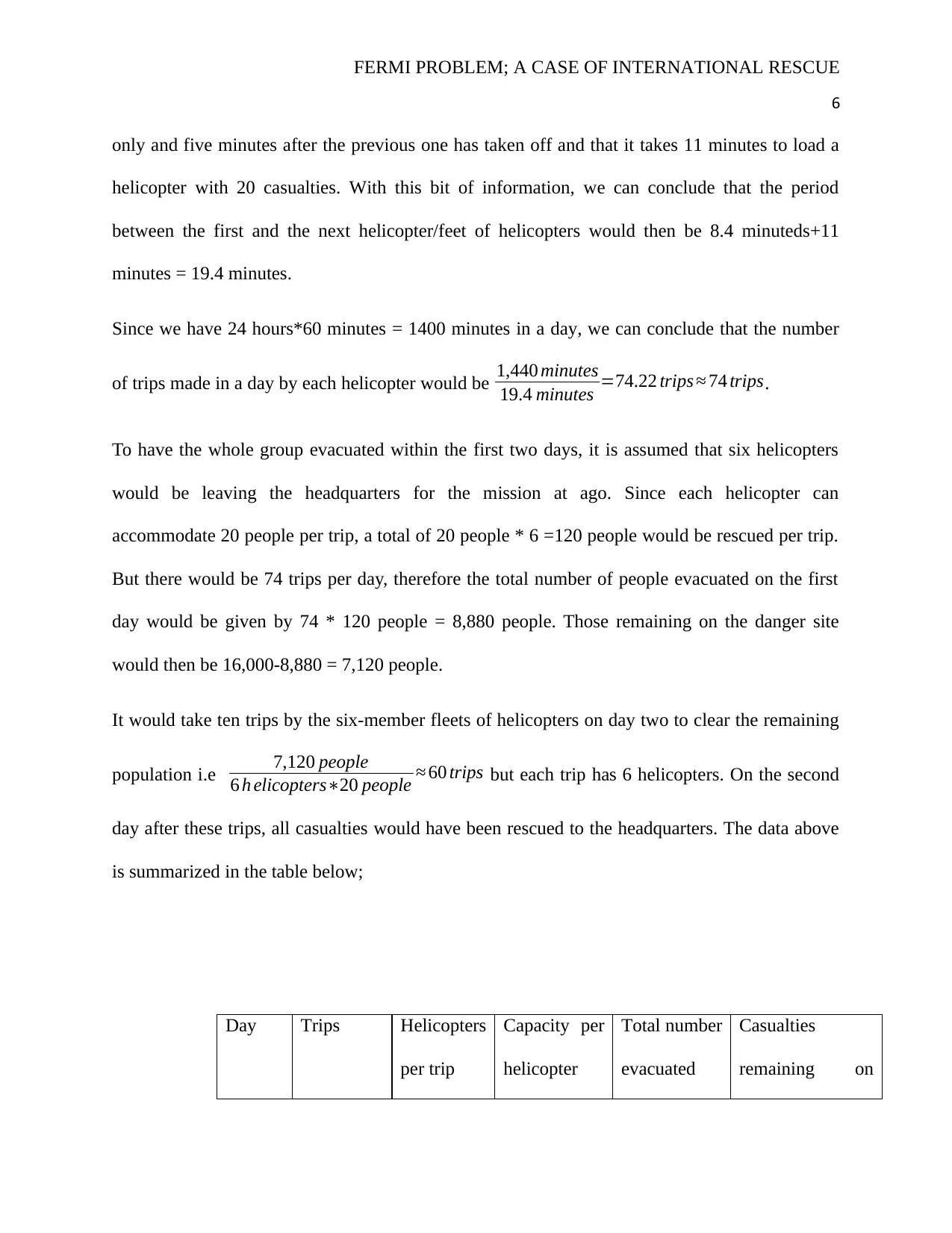
FERMI PROBLEM; A CASE OF INTERNATIONAL RESCUE
6
only and five minutes after the previous one has taken off and that it takes 11 minutes to load a
helicopter with 20 casualties. With this bit of information, we can conclude that the period
between the first and the next helicopter/feet of helicopters would then be 8.4 minuteds+11
minutes = 19.4 minutes.
Since we have 24 hours*60 minutes = 1400 minutes in a day, we can conclude that the number
of trips made in a day by each helicopter would be 1,440 minutes
19.4 minutes =74.22 trips ≈ 74 trips.
To have the whole group evacuated within the first two days, it is assumed that six helicopters
would be leaving the headquarters for the mission at ago. Since each helicopter can
accommodate 20 people per trip, a total of 20 people * 6 =120 people would be rescued per trip.
But there would be 74 trips per day, therefore the total number of people evacuated on the first
day would be given by 74 * 120 people = 8,880 people. Those remaining on the danger site
would then be 16,000-8,880 = 7,120 people.
It would take ten trips by the six-member fleets of helicopters on day two to clear the remaining
population i.e 7,120 people
6 h elicopters∗20 people ≈ 60 trips but each trip has 6 helicopters. On the second
day after these trips, all casualties would have been rescued to the headquarters. The data above
is summarized in the table below;
Day Trips Helicopters
per trip
Capacity per
helicopter
Total number
evacuated
Casualties
remaining on
6
only and five minutes after the previous one has taken off and that it takes 11 minutes to load a
helicopter with 20 casualties. With this bit of information, we can conclude that the period
between the first and the next helicopter/feet of helicopters would then be 8.4 minuteds+11
minutes = 19.4 minutes.
Since we have 24 hours*60 minutes = 1400 minutes in a day, we can conclude that the number
of trips made in a day by each helicopter would be 1,440 minutes
19.4 minutes =74.22 trips ≈ 74 trips.
To have the whole group evacuated within the first two days, it is assumed that six helicopters
would be leaving the headquarters for the mission at ago. Since each helicopter can
accommodate 20 people per trip, a total of 20 people * 6 =120 people would be rescued per trip.
But there would be 74 trips per day, therefore the total number of people evacuated on the first
day would be given by 74 * 120 people = 8,880 people. Those remaining on the danger site
would then be 16,000-8,880 = 7,120 people.
It would take ten trips by the six-member fleets of helicopters on day two to clear the remaining
population i.e 7,120 people
6 h elicopters∗20 people ≈ 60 trips but each trip has 6 helicopters. On the second
day after these trips, all casualties would have been rescued to the headquarters. The data above
is summarized in the table below;
Day Trips Helicopters
per trip
Capacity per
helicopter
Total number
evacuated
Casualties
remaining on
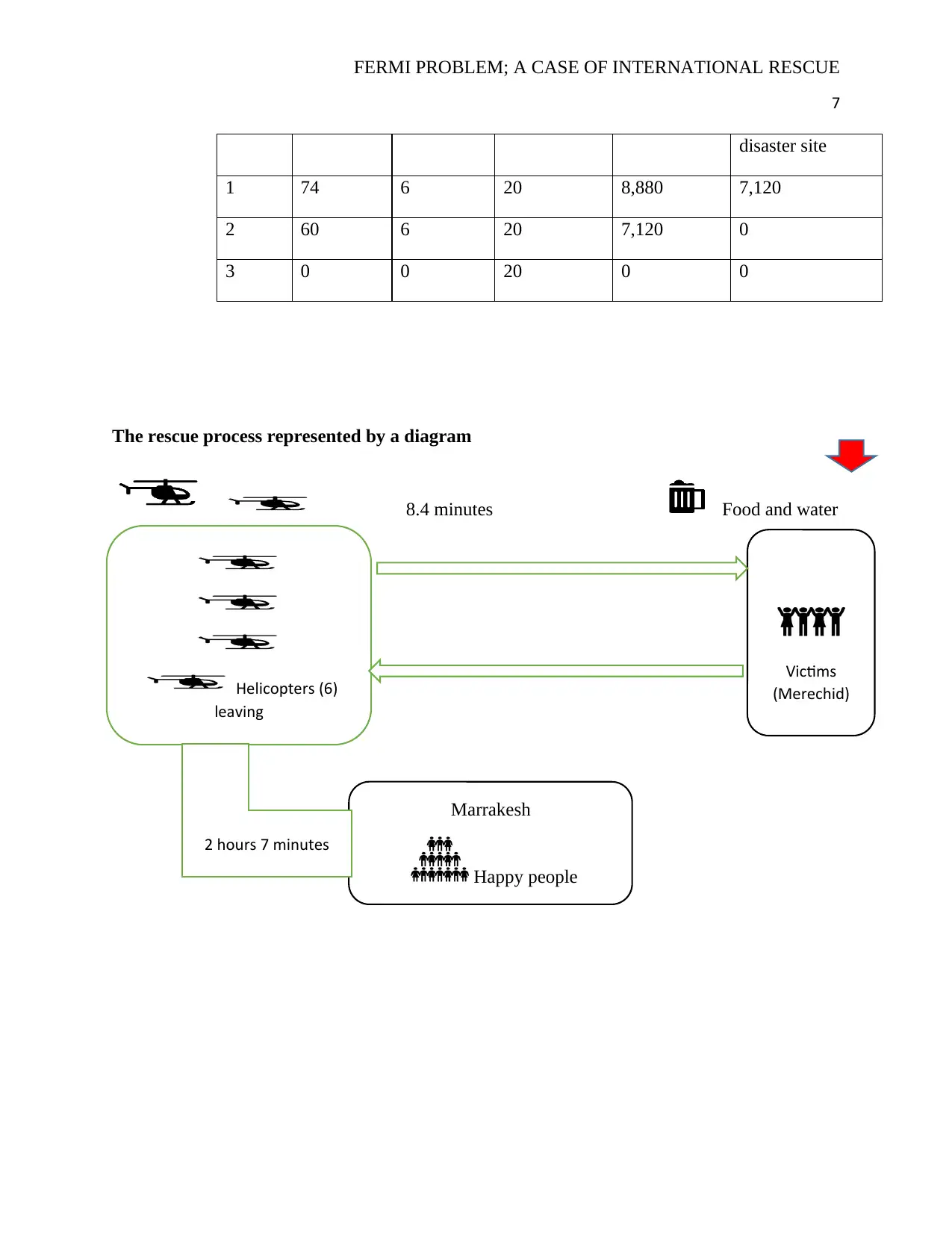
FERMI PROBLEM; A CASE OF INTERNATIONAL RESCUE
7
disaster site
1 74 6 20 8,880 7,120
2 60 6 20 7,120 0
3 0 0 20 0 0
The rescue process represented by a diagram
8.4 minutes Food and water
35 km in distance
Helicopters (6)
leaving
Victims
(Merechid)
Marrakesh
Happy people
2 hours 7 minutes
7
disaster site
1 74 6 20 8,880 7,120
2 60 6 20 7,120 0
3 0 0 20 0 0
The rescue process represented by a diagram
8.4 minutes Food and water
35 km in distance
Helicopters (6)
leaving
Victims
(Merechid)
Marrakesh
Happy people
2 hours 7 minutes
Paraphrase This Document
Need a fresh take? Get an instant paraphrase of this document with our AI Paraphraser
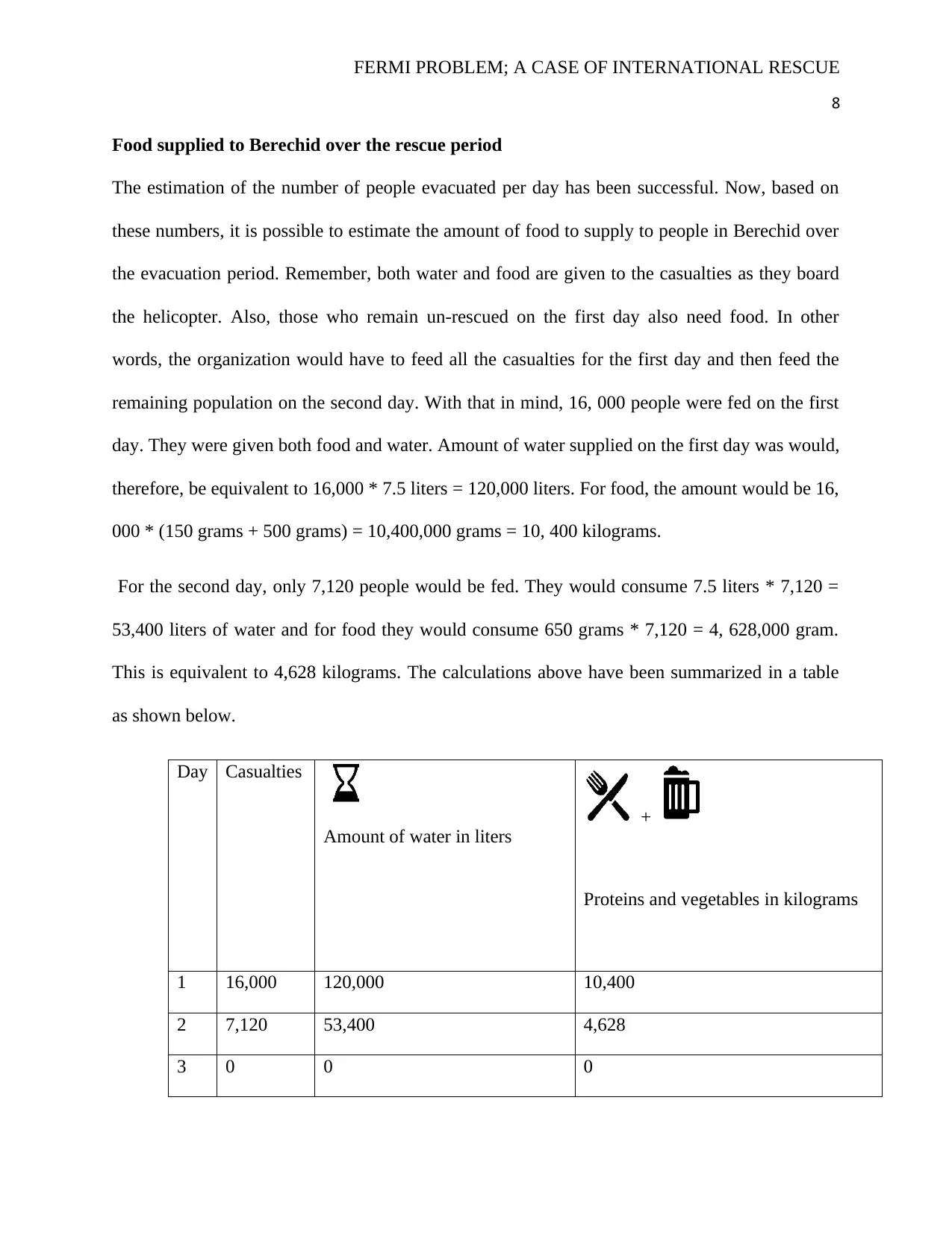
FERMI PROBLEM; A CASE OF INTERNATIONAL RESCUE
8
Food supplied to Berechid over the rescue period
The estimation of the number of people evacuated per day has been successful. Now, based on
these numbers, it is possible to estimate the amount of food to supply to people in Berechid over
the evacuation period. Remember, both water and food are given to the casualties as they board
the helicopter. Also, those who remain un-rescued on the first day also need food. In other
words, the organization would have to feed all the casualties for the first day and then feed the
remaining population on the second day. With that in mind, 16, 000 people were fed on the first
day. They were given both food and water. Amount of water supplied on the first day was would,
therefore, be equivalent to 16,000 * 7.5 liters = 120,000 liters. For food, the amount would be 16,
000 * (150 grams + 500 grams) = 10,400,000 grams = 10, 400 kilograms.
For the second day, only 7,120 people would be fed. They would consume 7.5 liters * 7,120 =
53,400 liters of water and for food they would consume 650 grams * 7,120 = 4, 628,000 gram.
This is equivalent to 4,628 kilograms. The calculations above have been summarized in a table
as shown below.
Day Casualties
Amount of water in liters
+
Proteins and vegetables in kilograms
1 16,000 120,000 10,400
2 7,120 53,400 4,628
3 0 0 0
8
Food supplied to Berechid over the rescue period
The estimation of the number of people evacuated per day has been successful. Now, based on
these numbers, it is possible to estimate the amount of food to supply to people in Berechid over
the evacuation period. Remember, both water and food are given to the casualties as they board
the helicopter. Also, those who remain un-rescued on the first day also need food. In other
words, the organization would have to feed all the casualties for the first day and then feed the
remaining population on the second day. With that in mind, 16, 000 people were fed on the first
day. They were given both food and water. Amount of water supplied on the first day was would,
therefore, be equivalent to 16,000 * 7.5 liters = 120,000 liters. For food, the amount would be 16,
000 * (150 grams + 500 grams) = 10,400,000 grams = 10, 400 kilograms.
For the second day, only 7,120 people would be fed. They would consume 7.5 liters * 7,120 =
53,400 liters of water and for food they would consume 650 grams * 7,120 = 4, 628,000 gram.
This is equivalent to 4,628 kilograms. The calculations above have been summarized in a table
as shown below.
Day Casualties
Amount of water in liters
+
Proteins and vegetables in kilograms
1 16,000 120,000 10,400
2 7,120 53,400 4,628
3 0 0 0
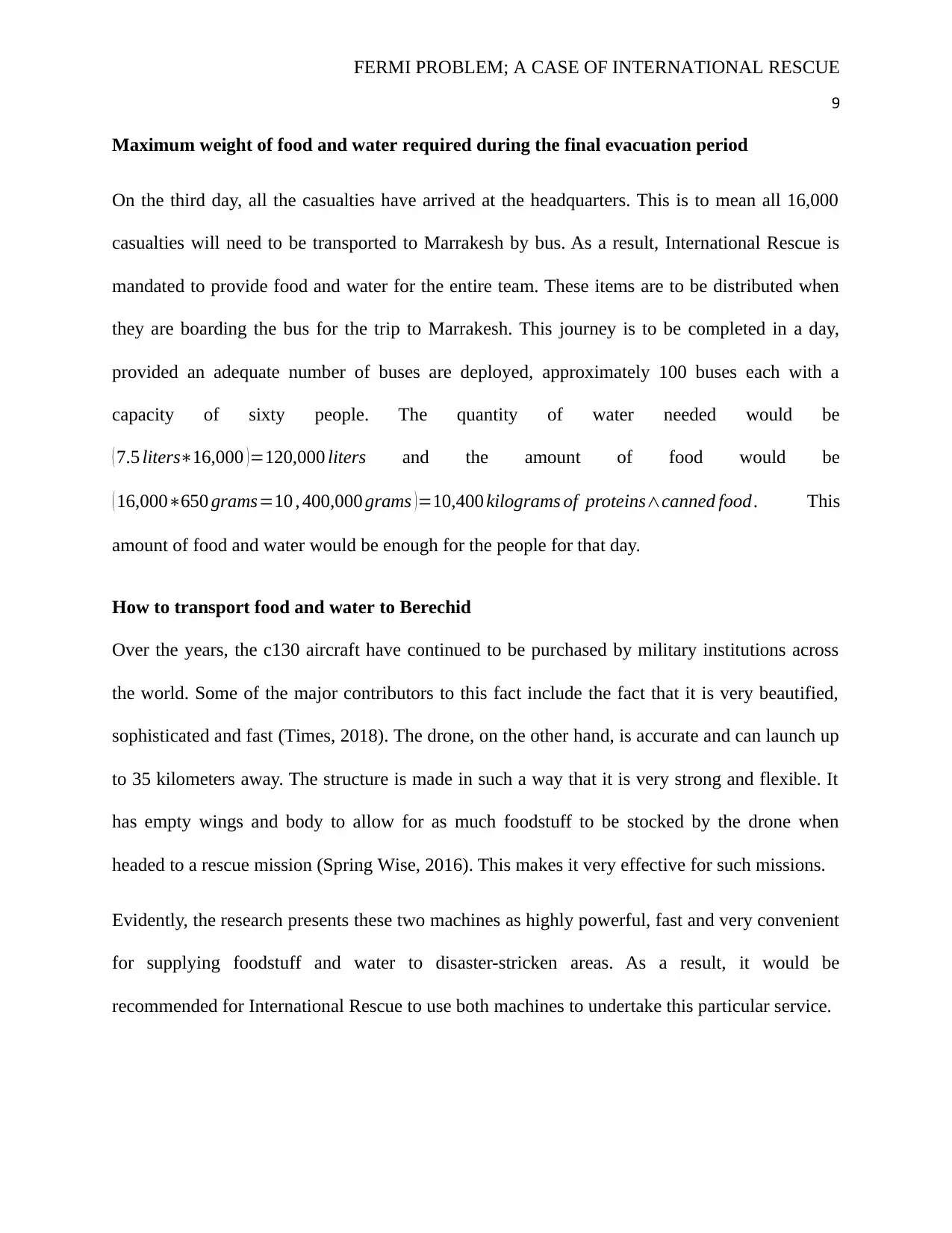
FERMI PROBLEM; A CASE OF INTERNATIONAL RESCUE
9
Maximum weight of food and water required during the final evacuation period
On the third day, all the casualties have arrived at the headquarters. This is to mean all 16,000
casualties will need to be transported to Marrakesh by bus. As a result, International Rescue is
mandated to provide food and water for the entire team. These items are to be distributed when
they are boarding the bus for the trip to Marrakesh. This journey is to be completed in a day,
provided an adequate number of buses are deployed, approximately 100 buses each with a
capacity of sixty people. The quantity of water needed would be
( 7.5 liters∗16,000 ) =120,000 liters and the amount of food would be
( 16,000∗650 grams=10 , 400,000 grams )=10,400 kilograms of proteins∧canned food. This
amount of food and water would be enough for the people for that day.
How to transport food and water to Berechid
Over the years, the c130 aircraft have continued to be purchased by military institutions across
the world. Some of the major contributors to this fact include the fact that it is very beautified,
sophisticated and fast (Times, 2018). The drone, on the other hand, is accurate and can launch up
to 35 kilometers away. The structure is made in such a way that it is very strong and flexible. It
has empty wings and body to allow for as much foodstuff to be stocked by the drone when
headed to a rescue mission (Spring Wise, 2016). This makes it very effective for such missions.
Evidently, the research presents these two machines as highly powerful, fast and very convenient
for supplying foodstuff and water to disaster-stricken areas. As a result, it would be
recommended for International Rescue to use both machines to undertake this particular service.
9
Maximum weight of food and water required during the final evacuation period
On the third day, all the casualties have arrived at the headquarters. This is to mean all 16,000
casualties will need to be transported to Marrakesh by bus. As a result, International Rescue is
mandated to provide food and water for the entire team. These items are to be distributed when
they are boarding the bus for the trip to Marrakesh. This journey is to be completed in a day,
provided an adequate number of buses are deployed, approximately 100 buses each with a
capacity of sixty people. The quantity of water needed would be
( 7.5 liters∗16,000 ) =120,000 liters and the amount of food would be
( 16,000∗650 grams=10 , 400,000 grams )=10,400 kilograms of proteins∧canned food. This
amount of food and water would be enough for the people for that day.
How to transport food and water to Berechid
Over the years, the c130 aircraft have continued to be purchased by military institutions across
the world. Some of the major contributors to this fact include the fact that it is very beautified,
sophisticated and fast (Times, 2018). The drone, on the other hand, is accurate and can launch up
to 35 kilometers away. The structure is made in such a way that it is very strong and flexible. It
has empty wings and body to allow for as much foodstuff to be stocked by the drone when
headed to a rescue mission (Spring Wise, 2016). This makes it very effective for such missions.
Evidently, the research presents these two machines as highly powerful, fast and very convenient
for supplying foodstuff and water to disaster-stricken areas. As a result, it would be
recommended for International Rescue to use both machines to undertake this particular service.
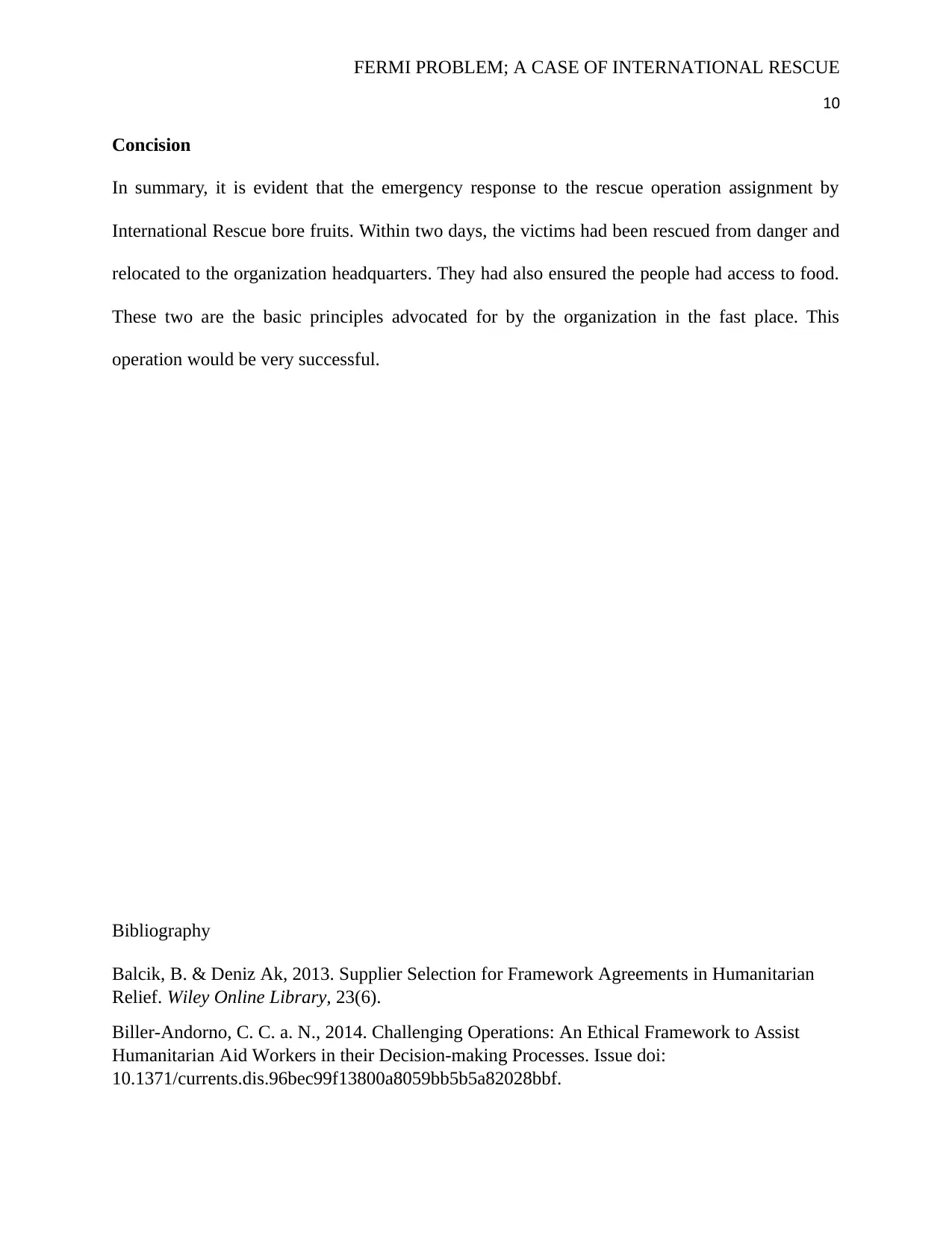
FERMI PROBLEM; A CASE OF INTERNATIONAL RESCUE
10
Concision
In summary, it is evident that the emergency response to the rescue operation assignment by
International Rescue bore fruits. Within two days, the victims had been rescued from danger and
relocated to the organization headquarters. They had also ensured the people had access to food.
These two are the basic principles advocated for by the organization in the fast place. This
operation would be very successful.
Bibliography
Balcik, B. & Deniz Ak, 2013. Supplier Selection for Framework Agreements in Humanitarian
Relief. Wiley Online Library, 23(6).
Biller-Andorno, C. C. a. N., 2014. Challenging Operations: An Ethical Framework to Assist
Humanitarian Aid Workers in their Decision-making Processes. Issue doi:
10.1371/currents.dis.96bec99f13800a8059bb5b5a82028bbf.
10
Concision
In summary, it is evident that the emergency response to the rescue operation assignment by
International Rescue bore fruits. Within two days, the victims had been rescued from danger and
relocated to the organization headquarters. They had also ensured the people had access to food.
These two are the basic principles advocated for by the organization in the fast place. This
operation would be very successful.
Bibliography
Balcik, B. & Deniz Ak, 2013. Supplier Selection for Framework Agreements in Humanitarian
Relief. Wiley Online Library, 23(6).
Biller-Andorno, C. C. a. N., 2014. Challenging Operations: An Ethical Framework to Assist
Humanitarian Aid Workers in their Decision-making Processes. Issue doi:
10.1371/currents.dis.96bec99f13800a8059bb5b5a82028bbf.
Secure Best Marks with AI Grader
Need help grading? Try our AI Grader for instant feedback on your assignments.
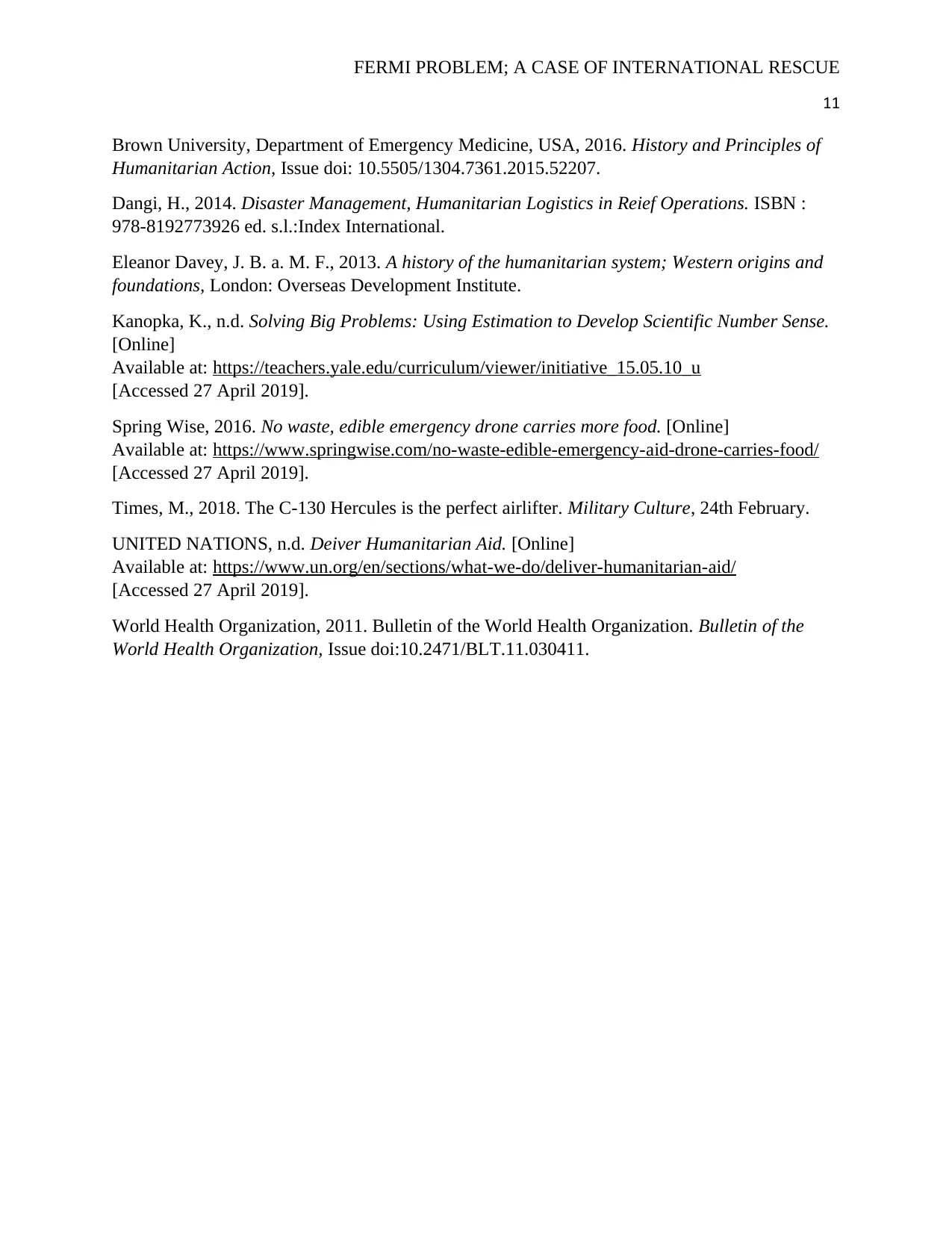
FERMI PROBLEM; A CASE OF INTERNATIONAL RESCUE
11
Brown University, Department of Emergency Medicine, USA, 2016. History and Principles of
Humanitarian Action, Issue doi: 10.5505/1304.7361.2015.52207.
Dangi, H., 2014. Disaster Management, Humanitarian Logistics in Reief Operations. ISBN :
978-8192773926 ed. s.l.:Index International.
Eleanor Davey, J. B. a. M. F., 2013. A history of the humanitarian system; Western origins and
foundations, London: Overseas Development Institute.
Kanopka, K., n.d. Solving Big Problems: Using Estimation to Develop Scientific Number Sense.
[Online]
Available at: https://teachers.yale.edu/curriculum/viewer/initiative_15.05.10_u
[Accessed 27 April 2019].
Spring Wise, 2016. No waste, edible emergency drone carries more food. [Online]
Available at: https://www.springwise.com/no-waste-edible-emergency-aid-drone-carries-food/
[Accessed 27 April 2019].
Times, M., 2018. The C-130 Hercules is the perfect airlifter. Military Culture, 24th February.
UNITED NATIONS, n.d. Deiver Humanitarian Aid. [Online]
Available at: https://www.un.org/en/sections/what-we-do/deliver-humanitarian-aid/
[Accessed 27 April 2019].
World Health Organization, 2011. Bulletin of the World Health Organization. Bulletin of the
World Health Organization, Issue doi:10.2471/BLT.11.030411.
11
Brown University, Department of Emergency Medicine, USA, 2016. History and Principles of
Humanitarian Action, Issue doi: 10.5505/1304.7361.2015.52207.
Dangi, H., 2014. Disaster Management, Humanitarian Logistics in Reief Operations. ISBN :
978-8192773926 ed. s.l.:Index International.
Eleanor Davey, J. B. a. M. F., 2013. A history of the humanitarian system; Western origins and
foundations, London: Overseas Development Institute.
Kanopka, K., n.d. Solving Big Problems: Using Estimation to Develop Scientific Number Sense.
[Online]
Available at: https://teachers.yale.edu/curriculum/viewer/initiative_15.05.10_u
[Accessed 27 April 2019].
Spring Wise, 2016. No waste, edible emergency drone carries more food. [Online]
Available at: https://www.springwise.com/no-waste-edible-emergency-aid-drone-carries-food/
[Accessed 27 April 2019].
Times, M., 2018. The C-130 Hercules is the perfect airlifter. Military Culture, 24th February.
UNITED NATIONS, n.d. Deiver Humanitarian Aid. [Online]
Available at: https://www.un.org/en/sections/what-we-do/deliver-humanitarian-aid/
[Accessed 27 April 2019].
World Health Organization, 2011. Bulletin of the World Health Organization. Bulletin of the
World Health Organization, Issue doi:10.2471/BLT.11.030411.
1 out of 11
Your All-in-One AI-Powered Toolkit for Academic Success.
+13062052269
info@desklib.com
Available 24*7 on WhatsApp / Email
![[object Object]](/_next/static/media/star-bottom.7253800d.svg)
Unlock your academic potential
© 2024 | Zucol Services PVT LTD | All rights reserved.

